Importance of Employee Motivation and Productivity at Next plc
VerifiedAdded on 2023/01/10
|45
|12176
|88
Project
AI Summary
This dissertation investigates the crucial role of employee motivation in enhancing organizational productivity, focusing on a case study of Next plc. The research begins with an introduction, outlining the background of the study, the rationale, research aims and objectives, research questions, and the structure of the dissertation. A comprehensive literature review explores the significance of employee motivation in the workplace, its impact on productivity, issues faced by Next plc in motivating staff, and strategies for long-term employee retention. The methodology section details the research approach, including the use of positivism philosophy, a deductive approach, and questionnaires for data collection. The study then presents data analysis and interpretation, utilizing frequency distribution analysis and MS Excel for graphical representations. The discussion section integrates secondary research to explain the findings. The conclusion summarizes the research and provides recommendations. The appendix includes the questionnaire used. The study aims to examine employee motivation's impact on organizational productivity, providing valuable insights for businesses like Next plc.
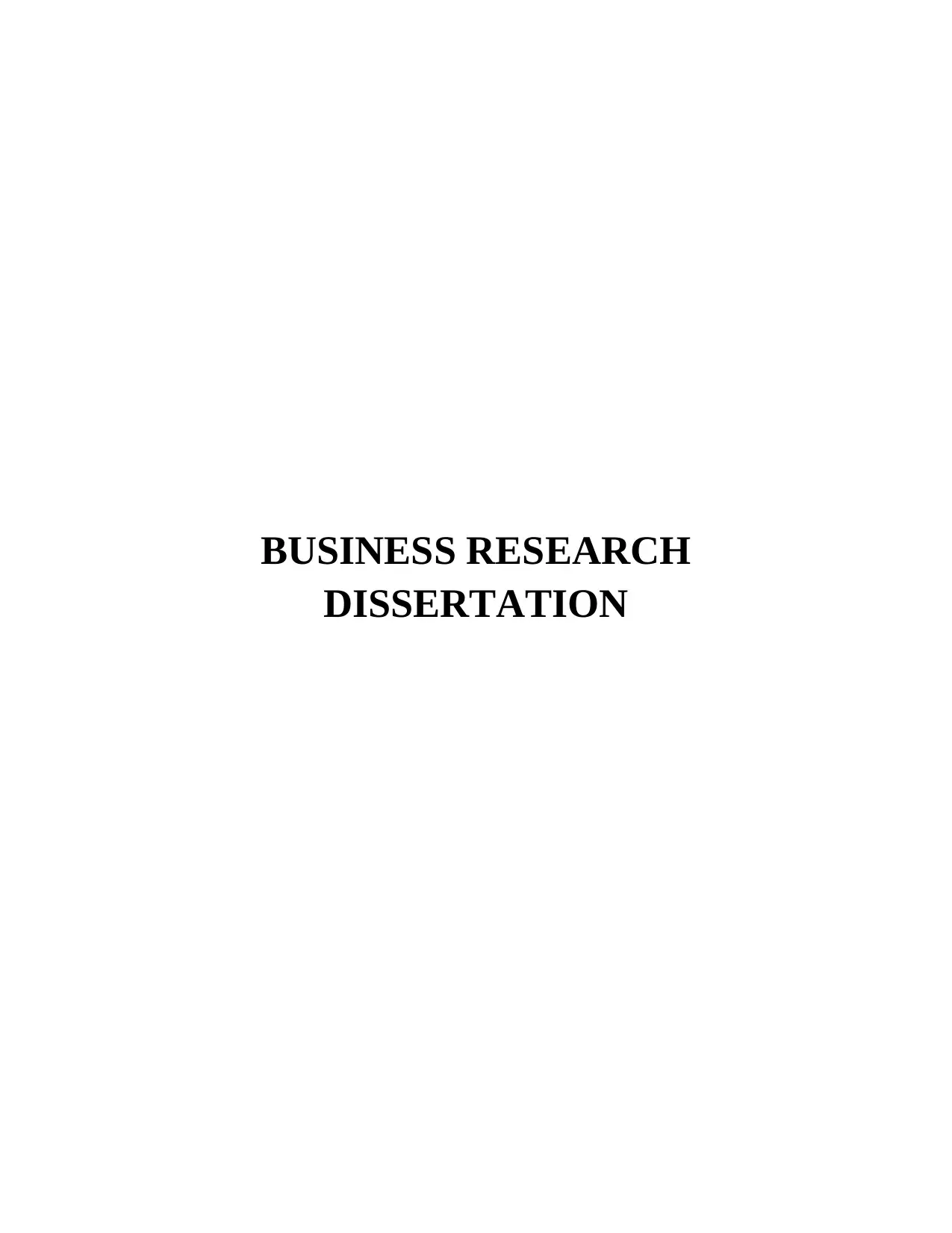
BUSINESS RESEARCH
DISSERTATION
DISSERTATION
Paraphrase This Document
Need a fresh take? Get an instant paraphrase of this document with our AI Paraphraser
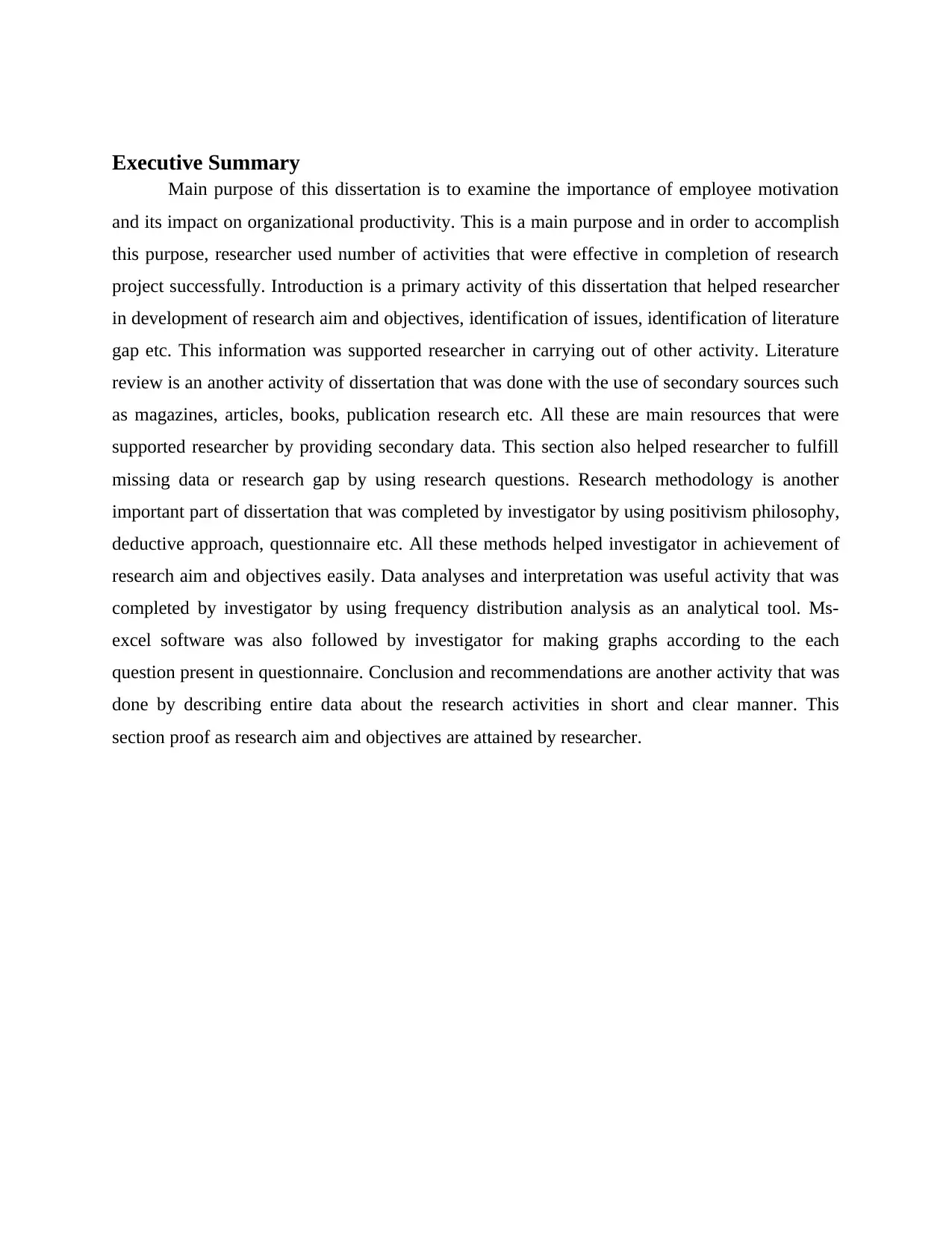
Executive Summary
Main purpose of this dissertation is to examine the importance of employee motivation
and its impact on organizational productivity. This is a main purpose and in order to accomplish
this purpose, researcher used number of activities that were effective in completion of research
project successfully. Introduction is a primary activity of this dissertation that helped researcher
in development of research aim and objectives, identification of issues, identification of literature
gap etc. This information was supported researcher in carrying out of other activity. Literature
review is an another activity of dissertation that was done with the use of secondary sources such
as magazines, articles, books, publication research etc. All these are main resources that were
supported researcher by providing secondary data. This section also helped researcher to fulfill
missing data or research gap by using research questions. Research methodology is another
important part of dissertation that was completed by investigator by using positivism philosophy,
deductive approach, questionnaire etc. All these methods helped investigator in achievement of
research aim and objectives easily. Data analyses and interpretation was useful activity that was
completed by investigator by using frequency distribution analysis as an analytical tool. Ms-
excel software was also followed by investigator for making graphs according to the each
question present in questionnaire. Conclusion and recommendations are another activity that was
done by describing entire data about the research activities in short and clear manner. This
section proof as research aim and objectives are attained by researcher.
Main purpose of this dissertation is to examine the importance of employee motivation
and its impact on organizational productivity. This is a main purpose and in order to accomplish
this purpose, researcher used number of activities that were effective in completion of research
project successfully. Introduction is a primary activity of this dissertation that helped researcher
in development of research aim and objectives, identification of issues, identification of literature
gap etc. This information was supported researcher in carrying out of other activity. Literature
review is an another activity of dissertation that was done with the use of secondary sources such
as magazines, articles, books, publication research etc. All these are main resources that were
supported researcher by providing secondary data. This section also helped researcher to fulfill
missing data or research gap by using research questions. Research methodology is another
important part of dissertation that was completed by investigator by using positivism philosophy,
deductive approach, questionnaire etc. All these methods helped investigator in achievement of
research aim and objectives easily. Data analyses and interpretation was useful activity that was
completed by investigator by using frequency distribution analysis as an analytical tool. Ms-
excel software was also followed by investigator for making graphs according to the each
question present in questionnaire. Conclusion and recommendations are another activity that was
done by describing entire data about the research activities in short and clear manner. This
section proof as research aim and objectives are attained by researcher.
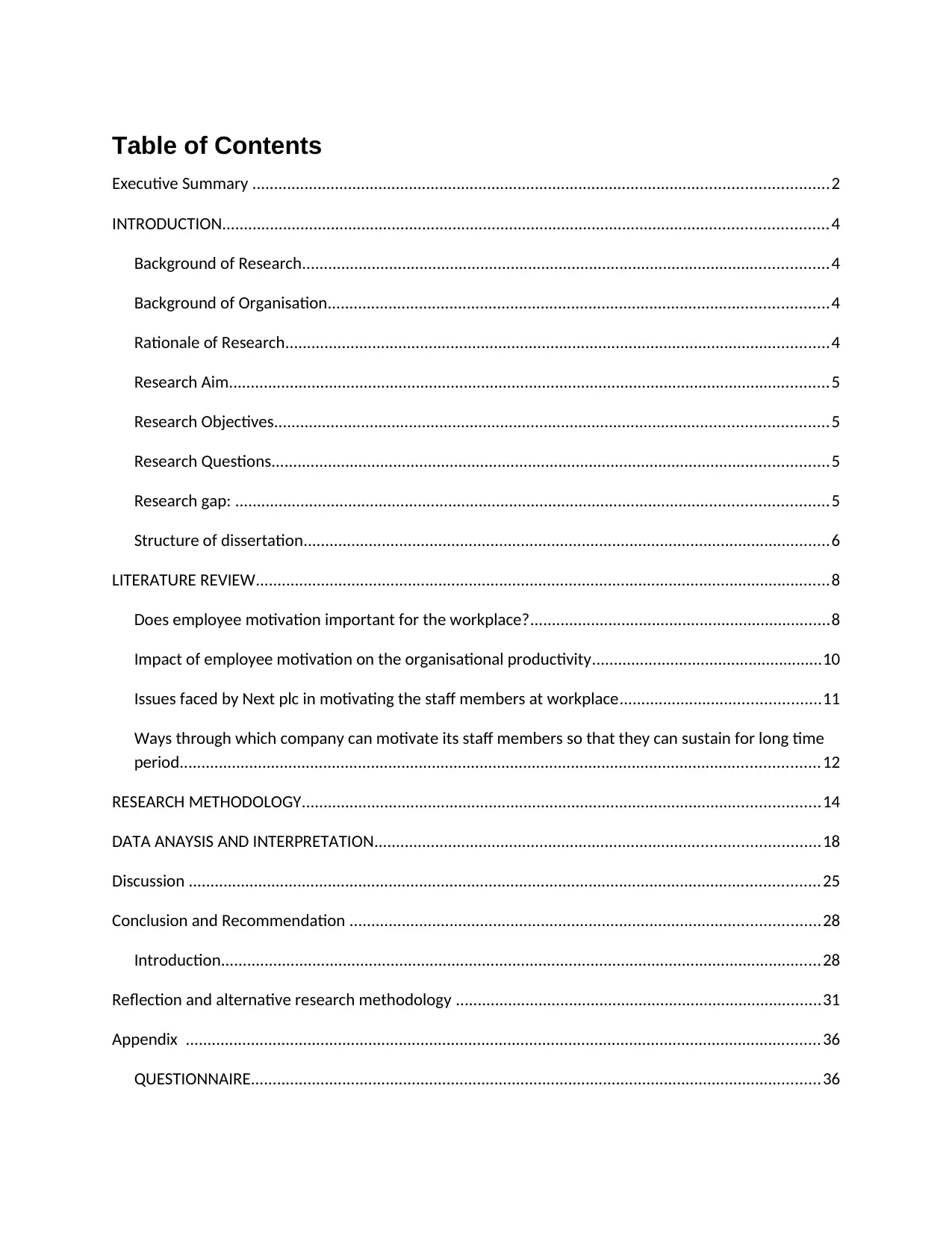
Table of Contents
Executive Summary ....................................................................................................................................2
INTRODUCTION...........................................................................................................................................4
Background of Research.........................................................................................................................4
Background of Organisation...................................................................................................................4
Rationale of Research.............................................................................................................................4
Research Aim..........................................................................................................................................5
Research Objectives...............................................................................................................................5
Research Questions................................................................................................................................5
Research gap: ........................................................................................................................................5
Structure of dissertation.........................................................................................................................6
LITERATURE REVIEW....................................................................................................................................8
Does employee motivation important for the workplace?.....................................................................8
Impact of employee motivation on the organisational productivity.....................................................10
Issues faced by Next plc in motivating the staff members at workplace..............................................11
Ways through which company can motivate its staff members so that they can sustain for long time
period...................................................................................................................................................12
RESEARCH METHODOLOGY.......................................................................................................................14
DATA ANAYSIS AND INTERPRETATION......................................................................................................18
Discussion .................................................................................................................................................25
Conclusion and Recommendation ............................................................................................................28
Introduction..........................................................................................................................................28
Reflection and alternative research methodology ....................................................................................31
Appendix ..................................................................................................................................................36
QUESTIONNAIRE...................................................................................................................................36
Executive Summary ....................................................................................................................................2
INTRODUCTION...........................................................................................................................................4
Background of Research.........................................................................................................................4
Background of Organisation...................................................................................................................4
Rationale of Research.............................................................................................................................4
Research Aim..........................................................................................................................................5
Research Objectives...............................................................................................................................5
Research Questions................................................................................................................................5
Research gap: ........................................................................................................................................5
Structure of dissertation.........................................................................................................................6
LITERATURE REVIEW....................................................................................................................................8
Does employee motivation important for the workplace?.....................................................................8
Impact of employee motivation on the organisational productivity.....................................................10
Issues faced by Next plc in motivating the staff members at workplace..............................................11
Ways through which company can motivate its staff members so that they can sustain for long time
period...................................................................................................................................................12
RESEARCH METHODOLOGY.......................................................................................................................14
DATA ANAYSIS AND INTERPRETATION......................................................................................................18
Discussion .................................................................................................................................................25
Conclusion and Recommendation ............................................................................................................28
Introduction..........................................................................................................................................28
Reflection and alternative research methodology ....................................................................................31
Appendix ..................................................................................................................................................36
QUESTIONNAIRE...................................................................................................................................36
⊘ This is a preview!⊘
Do you want full access?
Subscribe today to unlock all pages.

Trusted by 1+ million students worldwide

Paraphrase This Document
Need a fresh take? Get an instant paraphrase of this document with our AI Paraphraser
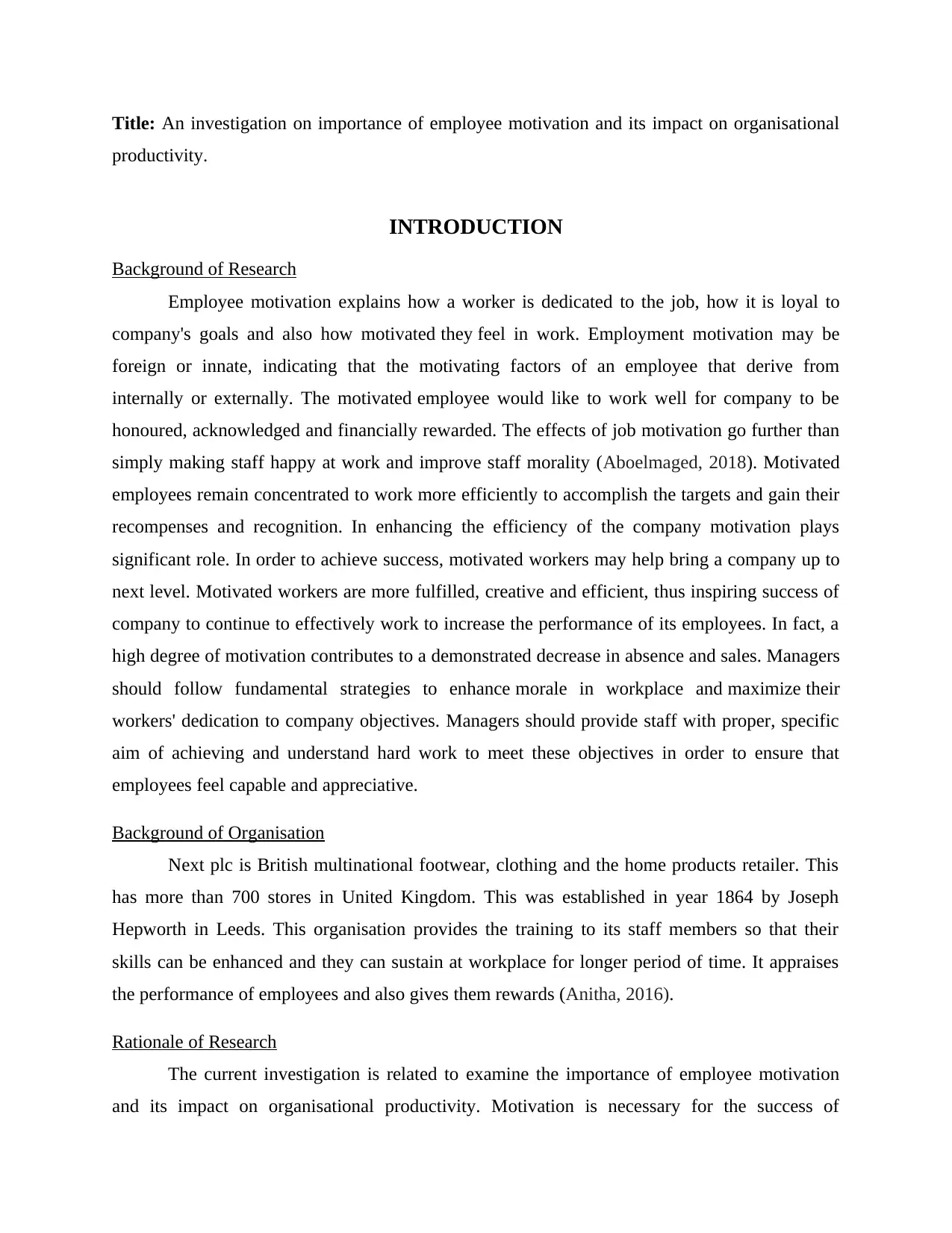
Title: An investigation on importance of employee motivation and its impact on organisational
productivity.
INTRODUCTION
Background of Research
Employee motivation explains how a worker is dedicated to the job, how it is loyal to
company's goals and also how motivated they feel in work. Employment motivation may be
foreign or innate, indicating that the motivating factors of an employee that derive from
internally or externally. The motivated employee would like to work well for company to be
honoured, acknowledged and financially rewarded. The effects of job motivation go further than
simply making staff happy at work and improve staff morality (Aboelmaged, 2018). Motivated
employees remain concentrated to work more efficiently to accomplish the targets and gain their
recompenses and recognition. In enhancing the efficiency of the company motivation plays
significant role. In order to achieve success, motivated workers may help bring a company up to
next level. Motivated workers are more fulfilled, creative and efficient, thus inspiring success of
company to continue to effectively work to increase the performance of its employees. In fact, a
high degree of motivation contributes to a demonstrated decrease in absence and sales. Managers
should follow fundamental strategies to enhance morale in workplace and maximize their
workers' dedication to company objectives. Managers should provide staff with proper, specific
aim of achieving and understand hard work to meet these objectives in order to ensure that
employees feel capable and appreciative.
Background of Organisation
Next plc is British multinational footwear, clothing and the home products retailer. This
has more than 700 stores in United Kingdom. This was established in year 1864 by Joseph
Hepworth in Leeds. This organisation provides the training to its staff members so that their
skills can be enhanced and they can sustain at workplace for longer period of time. It appraises
the performance of employees and also gives them rewards (Anitha, 2016).
Rationale of Research
The current investigation is related to examine the importance of employee motivation
and its impact on organisational productivity. Motivation is necessary for the success of
productivity.
INTRODUCTION
Background of Research
Employee motivation explains how a worker is dedicated to the job, how it is loyal to
company's goals and also how motivated they feel in work. Employment motivation may be
foreign or innate, indicating that the motivating factors of an employee that derive from
internally or externally. The motivated employee would like to work well for company to be
honoured, acknowledged and financially rewarded. The effects of job motivation go further than
simply making staff happy at work and improve staff morality (Aboelmaged, 2018). Motivated
employees remain concentrated to work more efficiently to accomplish the targets and gain their
recompenses and recognition. In enhancing the efficiency of the company motivation plays
significant role. In order to achieve success, motivated workers may help bring a company up to
next level. Motivated workers are more fulfilled, creative and efficient, thus inspiring success of
company to continue to effectively work to increase the performance of its employees. In fact, a
high degree of motivation contributes to a demonstrated decrease in absence and sales. Managers
should follow fundamental strategies to enhance morale in workplace and maximize their
workers' dedication to company objectives. Managers should provide staff with proper, specific
aim of achieving and understand hard work to meet these objectives in order to ensure that
employees feel capable and appreciative.
Background of Organisation
Next plc is British multinational footwear, clothing and the home products retailer. This
has more than 700 stores in United Kingdom. This was established in year 1864 by Joseph
Hepworth in Leeds. This organisation provides the training to its staff members so that their
skills can be enhanced and they can sustain at workplace for longer period of time. It appraises
the performance of employees and also gives them rewards (Anitha, 2016).
Rationale of Research
The current investigation is related to examine the importance of employee motivation
and its impact on organisational productivity. Motivation is necessary for the success of
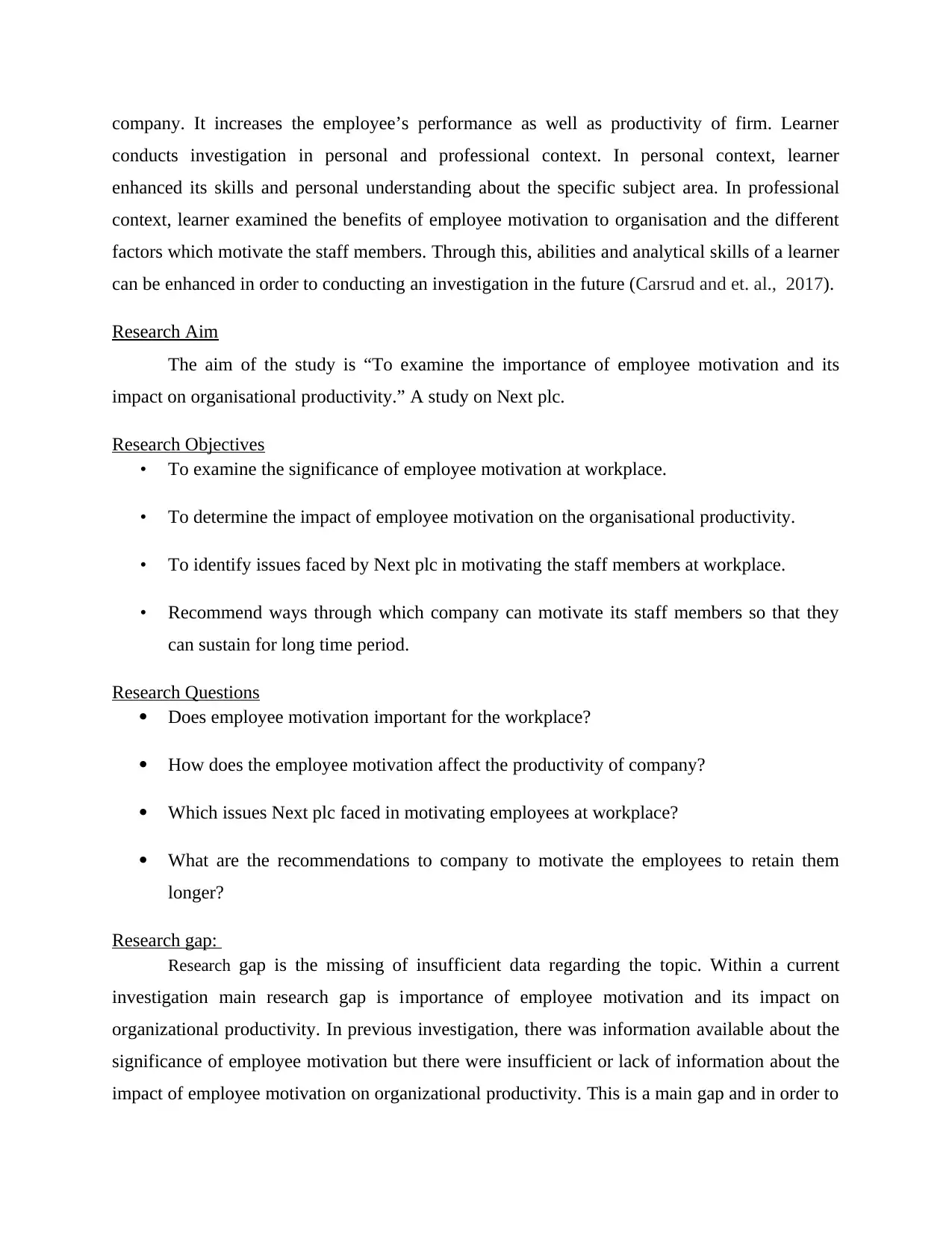
company. It increases the employee’s performance as well as productivity of firm. Learner
conducts investigation in personal and professional context. In personal context, learner
enhanced its skills and personal understanding about the specific subject area. In professional
context, learner examined the benefits of employee motivation to organisation and the different
factors which motivate the staff members. Through this, abilities and analytical skills of a learner
can be enhanced in order to conducting an investigation in the future (Carsrud and et. al., 2017).
Research Aim
The aim of the study is “To examine the importance of employee motivation and its
impact on organisational productivity.” A study on Next plc.
Research Objectives
• To examine the significance of employee motivation at workplace.
• To determine the impact of employee motivation on the organisational productivity.
• To identify issues faced by Next plc in motivating the staff members at workplace.
• Recommend ways through which company can motivate its staff members so that they
can sustain for long time period.
Research Questions
Does employee motivation important for the workplace?
How does the employee motivation affect the productivity of company?
Which issues Next plc faced in motivating employees at workplace?
What are the recommendations to company to motivate the employees to retain them
longer?
Research gap:
Research gap is the missing of insufficient data regarding the topic. Within a current
investigation main research gap is importance of employee motivation and its impact on
organizational productivity. In previous investigation, there was information available about the
significance of employee motivation but there were insufficient or lack of information about the
impact of employee motivation on organizational productivity. This is a main gap and in order to
conducts investigation in personal and professional context. In personal context, learner
enhanced its skills and personal understanding about the specific subject area. In professional
context, learner examined the benefits of employee motivation to organisation and the different
factors which motivate the staff members. Through this, abilities and analytical skills of a learner
can be enhanced in order to conducting an investigation in the future (Carsrud and et. al., 2017).
Research Aim
The aim of the study is “To examine the importance of employee motivation and its
impact on organisational productivity.” A study on Next plc.
Research Objectives
• To examine the significance of employee motivation at workplace.
• To determine the impact of employee motivation on the organisational productivity.
• To identify issues faced by Next plc in motivating the staff members at workplace.
• Recommend ways through which company can motivate its staff members so that they
can sustain for long time period.
Research Questions
Does employee motivation important for the workplace?
How does the employee motivation affect the productivity of company?
Which issues Next plc faced in motivating employees at workplace?
What are the recommendations to company to motivate the employees to retain them
longer?
Research gap:
Research gap is the missing of insufficient data regarding the topic. Within a current
investigation main research gap is importance of employee motivation and its impact on
organizational productivity. In previous investigation, there was information available about the
significance of employee motivation but there were insufficient or lack of information about the
impact of employee motivation on organizational productivity. This is a main gap and in order to
⊘ This is a preview!⊘
Do you want full access?
Subscribe today to unlock all pages.

Trusted by 1+ million students worldwide
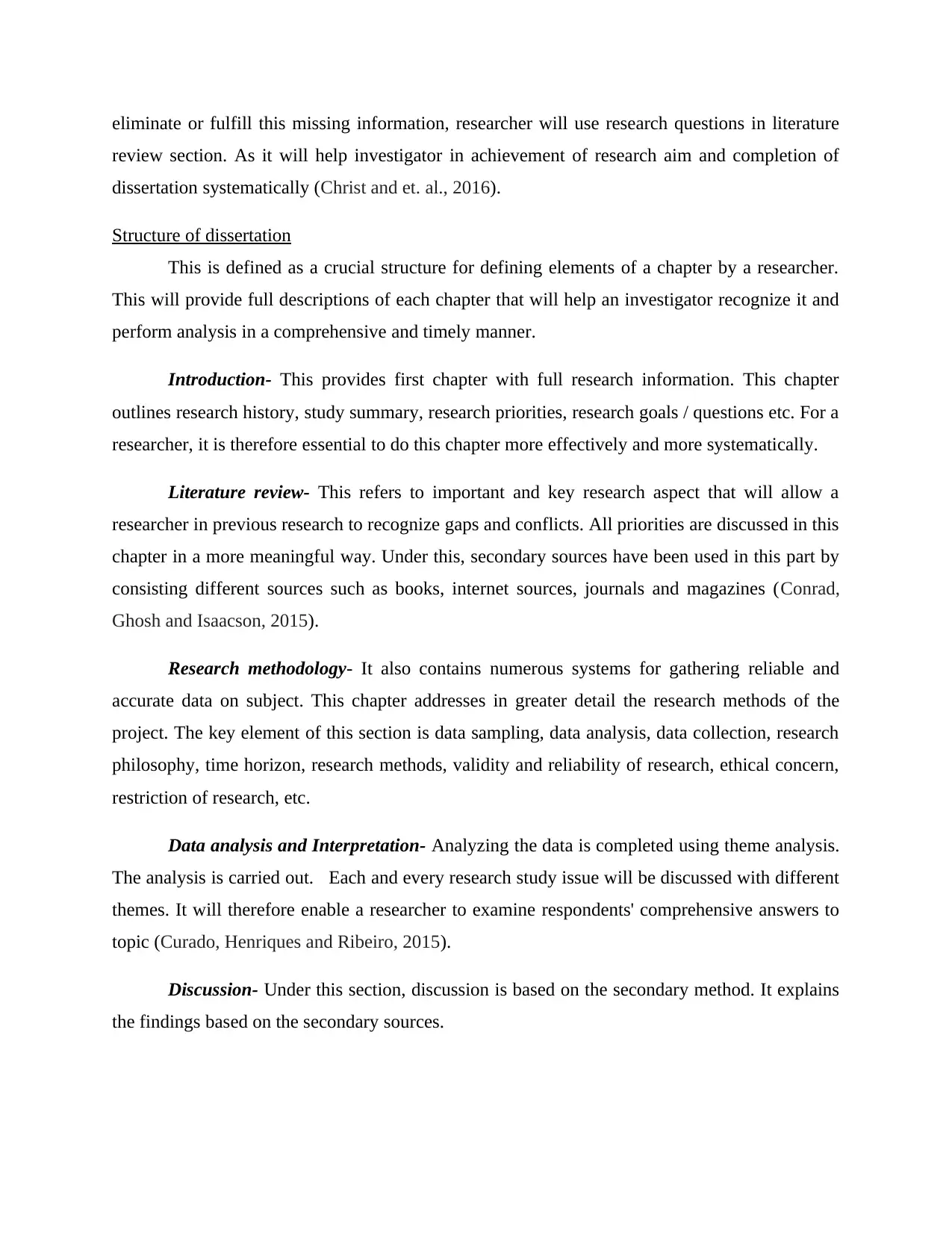
eliminate or fulfill this missing information, researcher will use research questions in literature
review section. As it will help investigator in achievement of research aim and completion of
dissertation systematically (Christ and et. al., 2016).
Structure of dissertation
This is defined as a crucial structure for defining elements of a chapter by a researcher.
This will provide full descriptions of each chapter that will help an investigator recognize it and
perform analysis in a comprehensive and timely manner.
Introduction- This provides first chapter with full research information. This chapter
outlines research history, study summary, research priorities, research goals / questions etc. For a
researcher, it is therefore essential to do this chapter more effectively and more systematically.
Literature review- This refers to important and key research aspect that will allow a
researcher in previous research to recognize gaps and conflicts. All priorities are discussed in this
chapter in a more meaningful way. Under this, secondary sources have been used in this part by
consisting different sources such as books, internet sources, journals and magazines (Conrad,
Ghosh and Isaacson, 2015).
Research methodology- It also contains numerous systems for gathering reliable and
accurate data on subject. This chapter addresses in greater detail the research methods of the
project. The key element of this section is data sampling, data analysis, data collection, research
philosophy, time horizon, research methods, validity and reliability of research, ethical concern,
restriction of research, etc.
Data analysis and Interpretation- Analyzing the data is completed using theme analysis.
The analysis is carried out. Each and every research study issue will be discussed with different
themes. It will therefore enable a researcher to examine respondents' comprehensive answers to
topic (Curado, Henriques and Ribeiro, 2015).
Discussion- Under this section, discussion is based on the secondary method. It explains
the findings based on the secondary sources.
review section. As it will help investigator in achievement of research aim and completion of
dissertation systematically (Christ and et. al., 2016).
Structure of dissertation
This is defined as a crucial structure for defining elements of a chapter by a researcher.
This will provide full descriptions of each chapter that will help an investigator recognize it and
perform analysis in a comprehensive and timely manner.
Introduction- This provides first chapter with full research information. This chapter
outlines research history, study summary, research priorities, research goals / questions etc. For a
researcher, it is therefore essential to do this chapter more effectively and more systematically.
Literature review- This refers to important and key research aspect that will allow a
researcher in previous research to recognize gaps and conflicts. All priorities are discussed in this
chapter in a more meaningful way. Under this, secondary sources have been used in this part by
consisting different sources such as books, internet sources, journals and magazines (Conrad,
Ghosh and Isaacson, 2015).
Research methodology- It also contains numerous systems for gathering reliable and
accurate data on subject. This chapter addresses in greater detail the research methods of the
project. The key element of this section is data sampling, data analysis, data collection, research
philosophy, time horizon, research methods, validity and reliability of research, ethical concern,
restriction of research, etc.
Data analysis and Interpretation- Analyzing the data is completed using theme analysis.
The analysis is carried out. Each and every research study issue will be discussed with different
themes. It will therefore enable a researcher to examine respondents' comprehensive answers to
topic (Curado, Henriques and Ribeiro, 2015).
Discussion- Under this section, discussion is based on the secondary method. It explains
the findings based on the secondary sources.
Paraphrase This Document
Need a fresh take? Get an instant paraphrase of this document with our AI Paraphraser
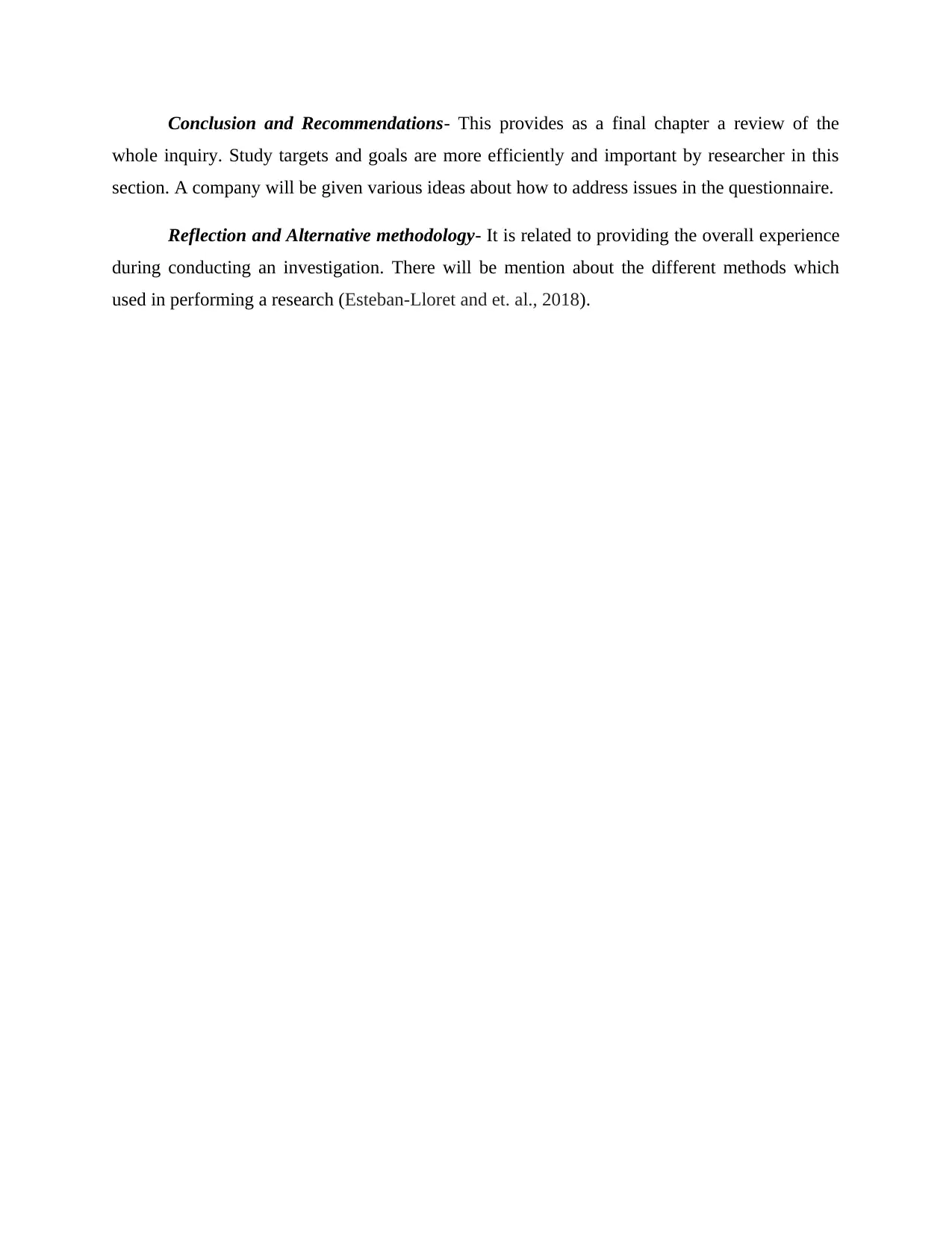
Conclusion and Recommendations- This provides as a final chapter a review of the
whole inquiry. Study targets and goals are more efficiently and important by researcher in this
section. A company will be given various ideas about how to address issues in the questionnaire.
Reflection and Alternative methodology- It is related to providing the overall experience
during conducting an investigation. There will be mention about the different methods which
used in performing a research (Esteban-Lloret and et. al., 2018).
whole inquiry. Study targets and goals are more efficiently and important by researcher in this
section. A company will be given various ideas about how to address issues in the questionnaire.
Reflection and Alternative methodology- It is related to providing the overall experience
during conducting an investigation. There will be mention about the different methods which
used in performing a research (Esteban-Lloret and et. al., 2018).
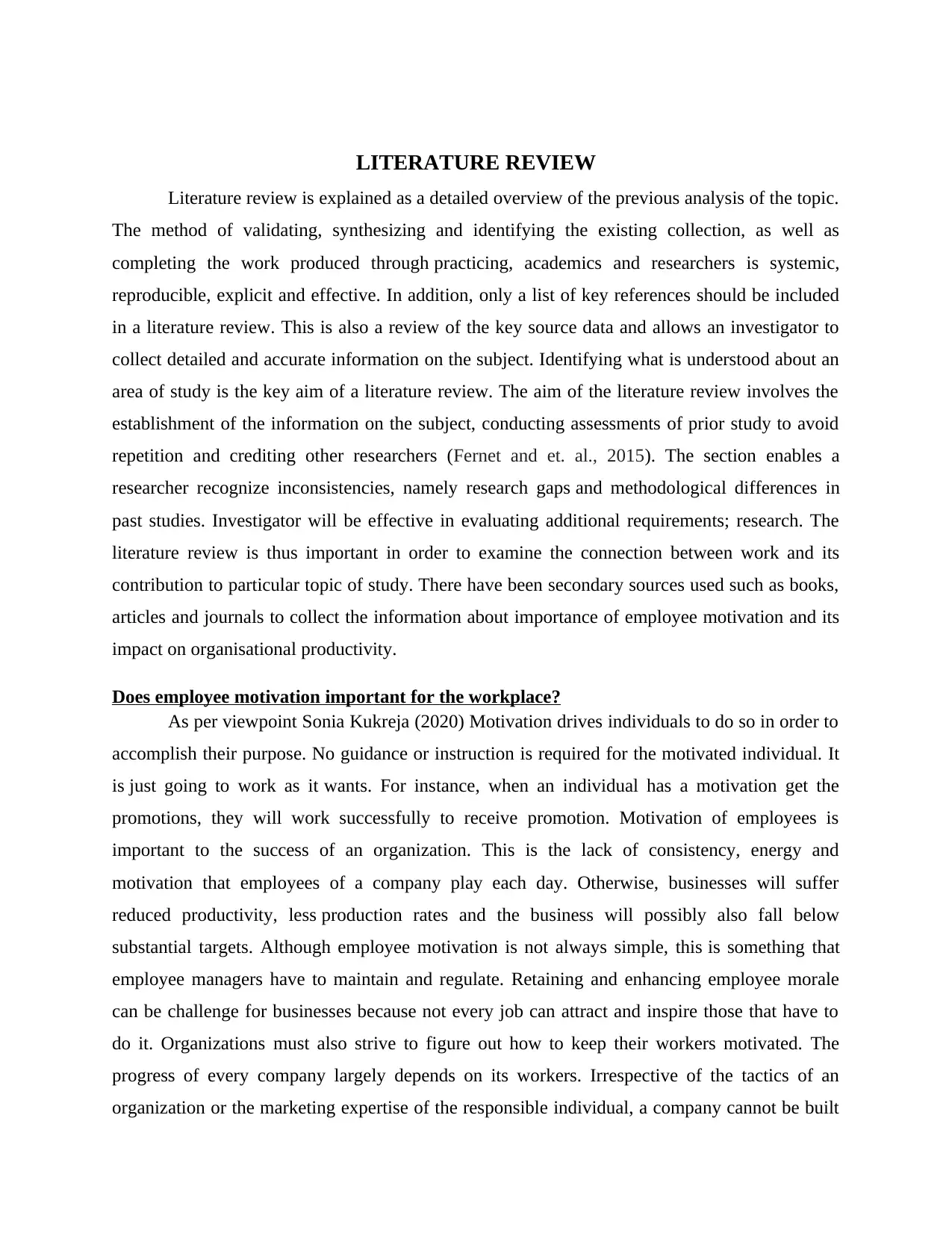
LITERATURE REVIEW
Literature review is explained as a detailed overview of the previous analysis of the topic.
The method of validating, synthesizing and identifying the existing collection, as well as
completing the work produced through practicing, academics and researchers is systemic,
reproducible, explicit and effective. In addition, only a list of key references should be included
in a literature review. This is also a review of the key source data and allows an investigator to
collect detailed and accurate information on the subject. Identifying what is understood about an
area of study is the key aim of a literature review. The aim of the literature review involves the
establishment of the information on the subject, conducting assessments of prior study to avoid
repetition and crediting other researchers (Fernet and et. al., 2015). The section enables a
researcher recognize inconsistencies, namely research gaps and methodological differences in
past studies. Investigator will be effective in evaluating additional requirements; research. The
literature review is thus important in order to examine the connection between work and its
contribution to particular topic of study. There have been secondary sources used such as books,
articles and journals to collect the information about importance of employee motivation and its
impact on organisational productivity.
Does employee motivation important for the workplace?
As per viewpoint Sonia Kukreja (2020) Motivation drives individuals to do so in order to
accomplish their purpose. No guidance or instruction is required for the motivated individual. It
is just going to work as it wants. For instance, when an individual has a motivation get the
promotions, they will work successfully to receive promotion. Motivation of employees is
important to the success of an organization. This is the lack of consistency, energy and
motivation that employees of a company play each day. Otherwise, businesses will suffer
reduced productivity, less production rates and the business will possibly also fall below
substantial targets. Although employee motivation is not always simple, this is something that
employee managers have to maintain and regulate. Retaining and enhancing employee morale
can be challenge for businesses because not every job can attract and inspire those that have to
do it. Organizations must also strive to figure out how to keep their workers motivated. The
progress of every company largely depends on its workers. Irrespective of the tactics of an
organization or the marketing expertise of the responsible individual, a company cannot be built
Literature review is explained as a detailed overview of the previous analysis of the topic.
The method of validating, synthesizing and identifying the existing collection, as well as
completing the work produced through practicing, academics and researchers is systemic,
reproducible, explicit and effective. In addition, only a list of key references should be included
in a literature review. This is also a review of the key source data and allows an investigator to
collect detailed and accurate information on the subject. Identifying what is understood about an
area of study is the key aim of a literature review. The aim of the literature review involves the
establishment of the information on the subject, conducting assessments of prior study to avoid
repetition and crediting other researchers (Fernet and et. al., 2015). The section enables a
researcher recognize inconsistencies, namely research gaps and methodological differences in
past studies. Investigator will be effective in evaluating additional requirements; research. The
literature review is thus important in order to examine the connection between work and its
contribution to particular topic of study. There have been secondary sources used such as books,
articles and journals to collect the information about importance of employee motivation and its
impact on organisational productivity.
Does employee motivation important for the workplace?
As per viewpoint Sonia Kukreja (2020) Motivation drives individuals to do so in order to
accomplish their purpose. No guidance or instruction is required for the motivated individual. It
is just going to work as it wants. For instance, when an individual has a motivation get the
promotions, they will work successfully to receive promotion. Motivation of employees is
important to the success of an organization. This is the lack of consistency, energy and
motivation that employees of a company play each day. Otherwise, businesses will suffer
reduced productivity, less production rates and the business will possibly also fall below
substantial targets. Although employee motivation is not always simple, this is something that
employee managers have to maintain and regulate. Retaining and enhancing employee morale
can be challenge for businesses because not every job can attract and inspire those that have to
do it. Organizations must also strive to figure out how to keep their workers motivated. The
progress of every company largely depends on its workers. Irrespective of the tactics of an
organization or the marketing expertise of the responsible individual, a company cannot be built
⊘ This is a preview!⊘
Do you want full access?
Subscribe today to unlock all pages.

Trusted by 1+ million students worldwide
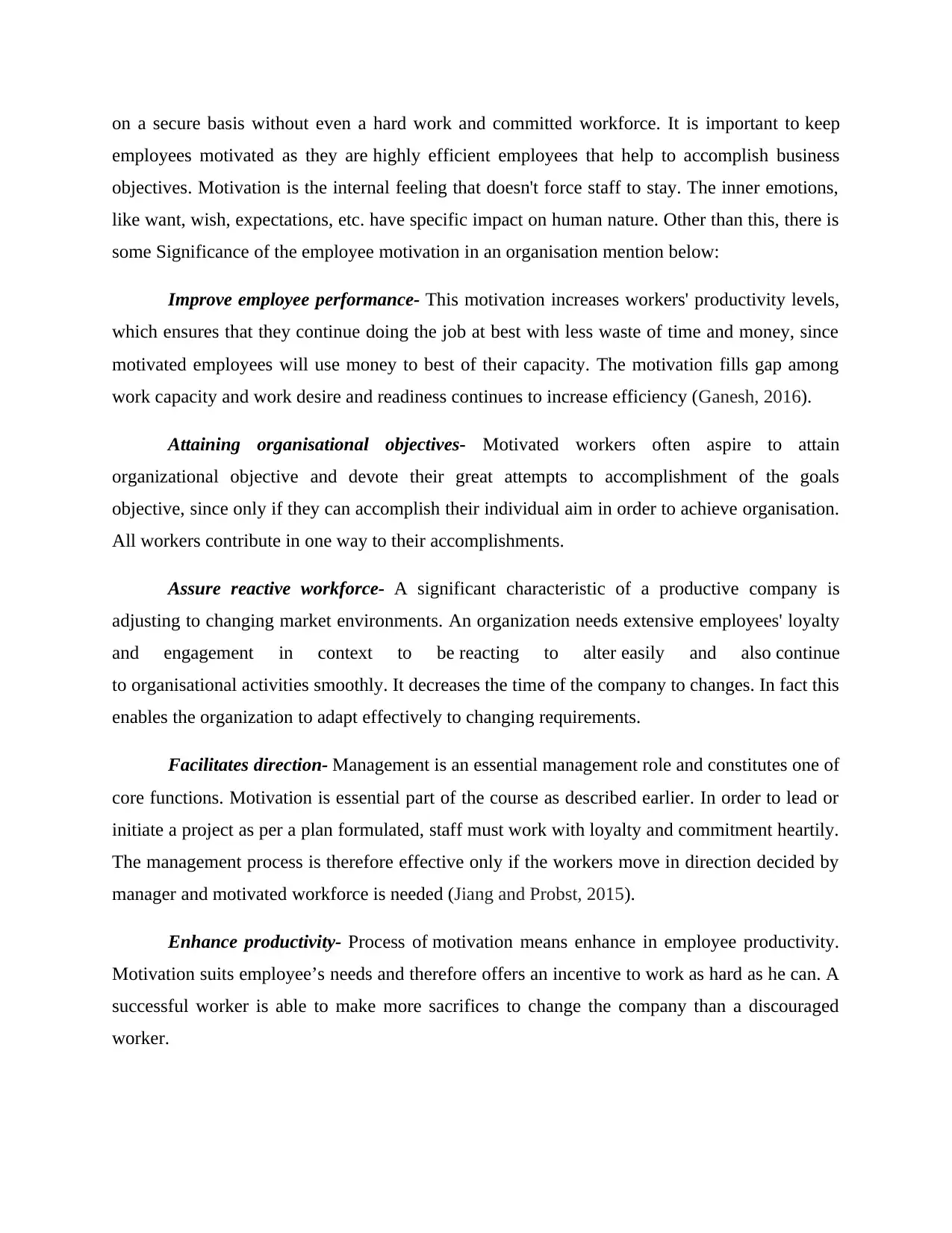
on a secure basis without even a hard work and committed workforce. It is important to keep
employees motivated as they are highly efficient employees that help to accomplish business
objectives. Motivation is the internal feeling that doesn't force staff to stay. The inner emotions,
like want, wish, expectations, etc. have specific impact on human nature. Other than this, there is
some Significance of the employee motivation in an organisation mention below:
Improve employee performance- This motivation increases workers' productivity levels,
which ensures that they continue doing the job at best with less waste of time and money, since
motivated employees will use money to best of their capacity. The motivation fills gap among
work capacity and work desire and readiness continues to increase efficiency (Ganesh, 2016).
Attaining organisational objectives- Motivated workers often aspire to attain
organizational objective and devote their great attempts to accomplishment of the goals
objective, since only if they can accomplish their individual aim in order to achieve organisation.
All workers contribute in one way to their accomplishments.
Assure reactive workforce- A significant characteristic of a productive company is
adjusting to changing market environments. An organization needs extensive employees' loyalty
and engagement in context to be reacting to alter easily and also continue
to organisational activities smoothly. It decreases the time of the company to changes. In fact this
enables the organization to adapt effectively to changing requirements.
Facilitates direction- Management is an essential management role and constitutes one of
core functions. Motivation is essential part of the course as described earlier. In order to lead or
initiate a project as per a plan formulated, staff must work with loyalty and commitment heartily.
The management process is therefore effective only if the workers move in direction decided by
manager and motivated workforce is needed (Jiang and Probst, 2015).
Enhance productivity- Process of motivation means enhance in employee productivity.
Motivation suits employee’s needs and therefore offers an incentive to work as hard as he can. A
successful worker is able to make more sacrifices to change the company than a discouraged
worker.
employees motivated as they are highly efficient employees that help to accomplish business
objectives. Motivation is the internal feeling that doesn't force staff to stay. The inner emotions,
like want, wish, expectations, etc. have specific impact on human nature. Other than this, there is
some Significance of the employee motivation in an organisation mention below:
Improve employee performance- This motivation increases workers' productivity levels,
which ensures that they continue doing the job at best with less waste of time and money, since
motivated employees will use money to best of their capacity. The motivation fills gap among
work capacity and work desire and readiness continues to increase efficiency (Ganesh, 2016).
Attaining organisational objectives- Motivated workers often aspire to attain
organizational objective and devote their great attempts to accomplishment of the goals
objective, since only if they can accomplish their individual aim in order to achieve organisation.
All workers contribute in one way to their accomplishments.
Assure reactive workforce- A significant characteristic of a productive company is
adjusting to changing market environments. An organization needs extensive employees' loyalty
and engagement in context to be reacting to alter easily and also continue
to organisational activities smoothly. It decreases the time of the company to changes. In fact this
enables the organization to adapt effectively to changing requirements.
Facilitates direction- Management is an essential management role and constitutes one of
core functions. Motivation is essential part of the course as described earlier. In order to lead or
initiate a project as per a plan formulated, staff must work with loyalty and commitment heartily.
The management process is therefore effective only if the workers move in direction decided by
manager and motivated workforce is needed (Jiang and Probst, 2015).
Enhance productivity- Process of motivation means enhance in employee productivity.
Motivation suits employee’s needs and therefore offers an incentive to work as hard as he can. A
successful worker is able to make more sacrifices to change the company than a discouraged
worker.
Paraphrase This Document
Need a fresh take? Get an instant paraphrase of this document with our AI Paraphraser
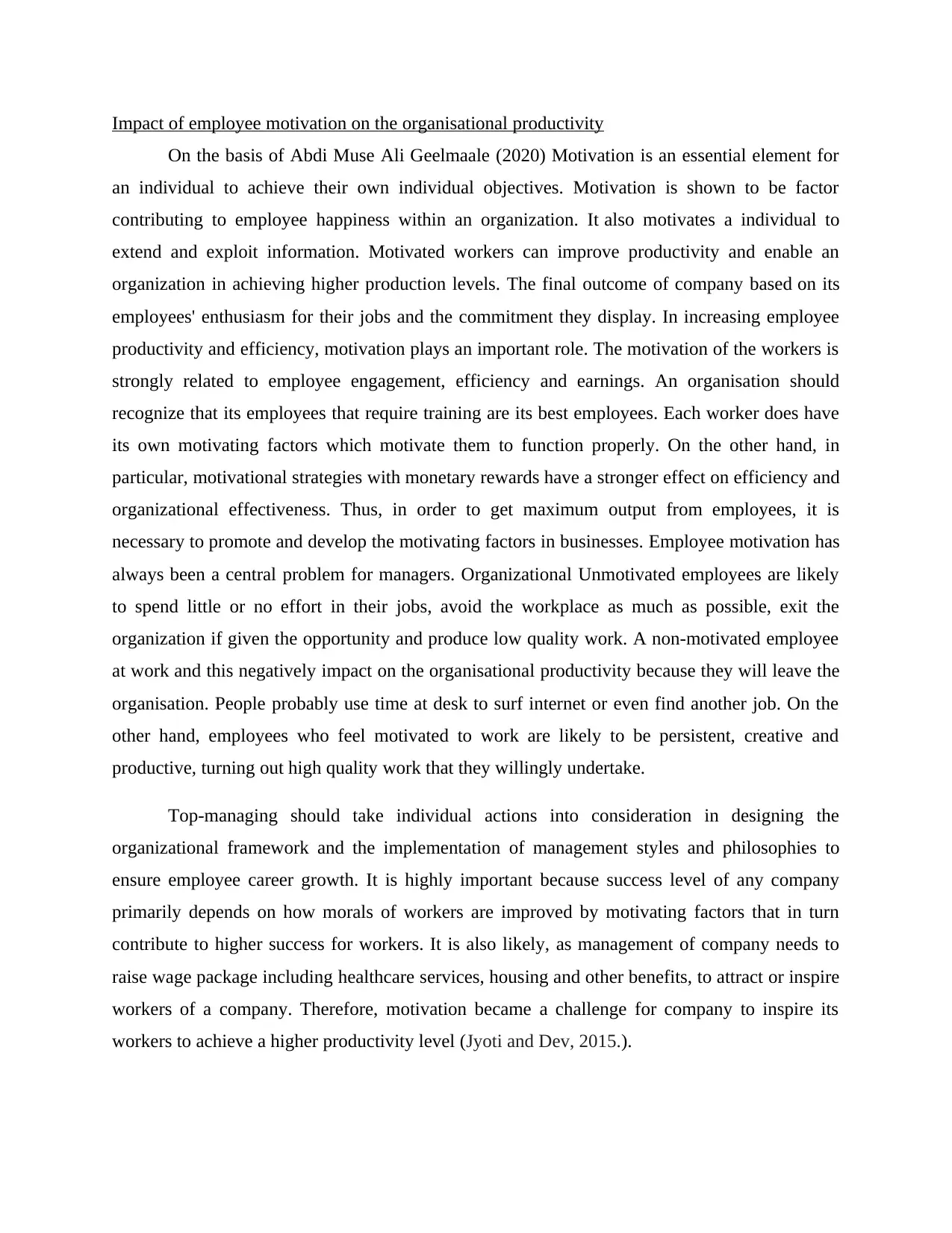
Impact of employee motivation on the organisational productivity
On the basis of Abdi Muse Ali Geelmaale (2020) Motivation is an essential element for
an individual to achieve their own individual objectives. Motivation is shown to be factor
contributing to employee happiness within an organization. It also motivates a individual to
extend and exploit information. Motivated workers can improve productivity and enable an
organization in achieving higher production levels. The final outcome of company based on its
employees' enthusiasm for their jobs and the commitment they display. In increasing employee
productivity and efficiency, motivation plays an important role. The motivation of the workers is
strongly related to employee engagement, efficiency and earnings. An organisation should
recognize that its employees that require training are its best employees. Each worker does have
its own motivating factors which motivate them to function properly. On the other hand, in
particular, motivational strategies with monetary rewards have a stronger effect on efficiency and
organizational effectiveness. Thus, in order to get maximum output from employees, it is
necessary to promote and develop the motivating factors in businesses. Employee motivation has
always been a central problem for managers. Organizational Unmotivated employees are likely
to spend little or no effort in their jobs, avoid the workplace as much as possible, exit the
organization if given the opportunity and produce low quality work. A non-motivated employee
at work and this negatively impact on the organisational productivity because they will leave the
organisation. People probably use time at desk to surf internet or even find another job. On the
other hand, employees who feel motivated to work are likely to be persistent, creative and
productive, turning out high quality work that they willingly undertake.
Top-managing should take individual actions into consideration in designing the
organizational framework and the implementation of management styles and philosophies to
ensure employee career growth. It is highly important because success level of any company
primarily depends on how morals of workers are improved by motivating factors that in turn
contribute to higher success for workers. It is also likely, as management of company needs to
raise wage package including healthcare services, housing and other benefits, to attract or inspire
workers of a company. Therefore, motivation became a challenge for company to inspire its
workers to achieve a higher productivity level (Jyoti and Dev, 2015.).
On the basis of Abdi Muse Ali Geelmaale (2020) Motivation is an essential element for
an individual to achieve their own individual objectives. Motivation is shown to be factor
contributing to employee happiness within an organization. It also motivates a individual to
extend and exploit information. Motivated workers can improve productivity and enable an
organization in achieving higher production levels. The final outcome of company based on its
employees' enthusiasm for their jobs and the commitment they display. In increasing employee
productivity and efficiency, motivation plays an important role. The motivation of the workers is
strongly related to employee engagement, efficiency and earnings. An organisation should
recognize that its employees that require training are its best employees. Each worker does have
its own motivating factors which motivate them to function properly. On the other hand, in
particular, motivational strategies with monetary rewards have a stronger effect on efficiency and
organizational effectiveness. Thus, in order to get maximum output from employees, it is
necessary to promote and develop the motivating factors in businesses. Employee motivation has
always been a central problem for managers. Organizational Unmotivated employees are likely
to spend little or no effort in their jobs, avoid the workplace as much as possible, exit the
organization if given the opportunity and produce low quality work. A non-motivated employee
at work and this negatively impact on the organisational productivity because they will leave the
organisation. People probably use time at desk to surf internet or even find another job. On the
other hand, employees who feel motivated to work are likely to be persistent, creative and
productive, turning out high quality work that they willingly undertake.
Top-managing should take individual actions into consideration in designing the
organizational framework and the implementation of management styles and philosophies to
ensure employee career growth. It is highly important because success level of any company
primarily depends on how morals of workers are improved by motivating factors that in turn
contribute to higher success for workers. It is also likely, as management of company needs to
raise wage package including healthcare services, housing and other benefits, to attract or inspire
workers of a company. Therefore, motivation became a challenge for company to inspire its
workers to achieve a higher productivity level (Jyoti and Dev, 2015.).
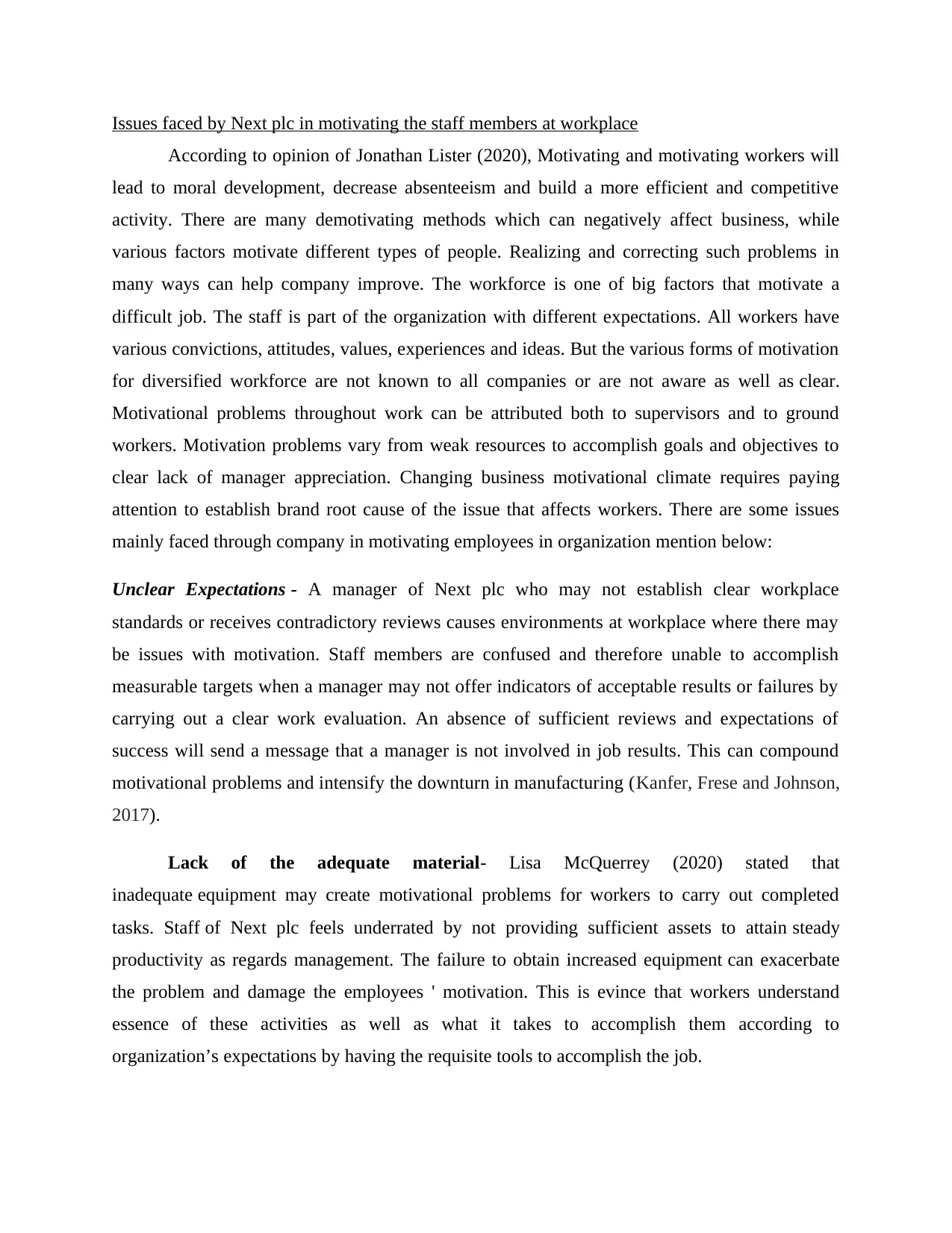
Issues faced by Next plc in motivating the staff members at workplace
According to opinion of Jonathan Lister (2020), Motivating and motivating workers will
lead to moral development, decrease absenteeism and build a more efficient and competitive
activity. There are many demotivating methods which can negatively affect business, while
various factors motivate different types of people. Realizing and correcting such problems in
many ways can help company improve. The workforce is one of big factors that motivate a
difficult job. The staff is part of the organization with different expectations. All workers have
various convictions, attitudes, values, experiences and ideas. But the various forms of motivation
for diversified workforce are not known to all companies or are not aware as well as clear.
Motivational problems throughout work can be attributed both to supervisors and to ground
workers. Motivation problems vary from weak resources to accomplish goals and objectives to
clear lack of manager appreciation. Changing business motivational climate requires paying
attention to establish brand root cause of the issue that affects workers. There are some issues
mainly faced through company in motivating employees in organization mention below:
Unclear Expectations - A manager of Next plc who may not establish clear workplace
standards or receives contradictory reviews causes environments at workplace where there may
be issues with motivation. Staff members are confused and therefore unable to accomplish
measurable targets when a manager may not offer indicators of acceptable results or failures by
carrying out a clear work evaluation. An absence of sufficient reviews and expectations of
success will send a message that a manager is not involved in job results. This can compound
motivational problems and intensify the downturn in manufacturing (Kanfer, Frese and Johnson,
2017).
Lack of the adequate material- Lisa McQuerrey (2020) stated that
inadequate equipment may create motivational problems for workers to carry out completed
tasks. Staff of Next plc feels underrated by not providing sufficient assets to attain steady
productivity as regards management. The failure to obtain increased equipment can exacerbate
the problem and damage the employees ' motivation. This is evince that workers understand
essence of these activities as well as what it takes to accomplish them according to
organization’s expectations by having the requisite tools to accomplish the job.
According to opinion of Jonathan Lister (2020), Motivating and motivating workers will
lead to moral development, decrease absenteeism and build a more efficient and competitive
activity. There are many demotivating methods which can negatively affect business, while
various factors motivate different types of people. Realizing and correcting such problems in
many ways can help company improve. The workforce is one of big factors that motivate a
difficult job. The staff is part of the organization with different expectations. All workers have
various convictions, attitudes, values, experiences and ideas. But the various forms of motivation
for diversified workforce are not known to all companies or are not aware as well as clear.
Motivational problems throughout work can be attributed both to supervisors and to ground
workers. Motivation problems vary from weak resources to accomplish goals and objectives to
clear lack of manager appreciation. Changing business motivational climate requires paying
attention to establish brand root cause of the issue that affects workers. There are some issues
mainly faced through company in motivating employees in organization mention below:
Unclear Expectations - A manager of Next plc who may not establish clear workplace
standards or receives contradictory reviews causes environments at workplace where there may
be issues with motivation. Staff members are confused and therefore unable to accomplish
measurable targets when a manager may not offer indicators of acceptable results or failures by
carrying out a clear work evaluation. An absence of sufficient reviews and expectations of
success will send a message that a manager is not involved in job results. This can compound
motivational problems and intensify the downturn in manufacturing (Kanfer, Frese and Johnson,
2017).
Lack of the adequate material- Lisa McQuerrey (2020) stated that
inadequate equipment may create motivational problems for workers to carry out completed
tasks. Staff of Next plc feels underrated by not providing sufficient assets to attain steady
productivity as regards management. The failure to obtain increased equipment can exacerbate
the problem and damage the employees ' motivation. This is evince that workers understand
essence of these activities as well as what it takes to accomplish them according to
organization’s expectations by having the requisite tools to accomplish the job.
⊘ This is a preview!⊘
Do you want full access?
Subscribe today to unlock all pages.

Trusted by 1+ million students worldwide
1 out of 45
Related Documents
Your All-in-One AI-Powered Toolkit for Academic Success.
+13062052269
info@desklib.com
Available 24*7 on WhatsApp / Email
![[object Object]](/_next/static/media/star-bottom.7253800d.svg)
Unlock your academic potential
Copyright © 2020–2025 A2Z Services. All Rights Reserved. Developed and managed by ZUCOL.





